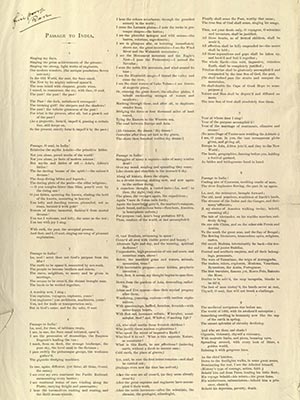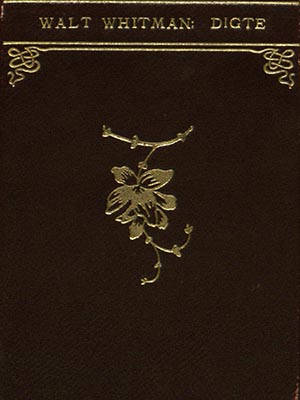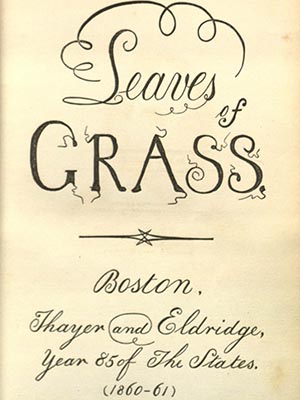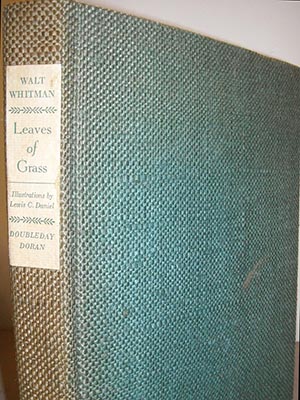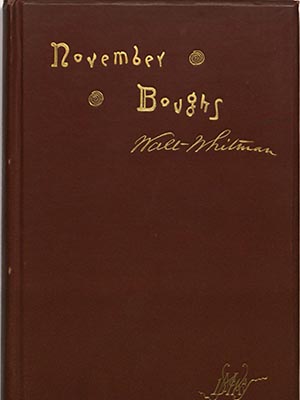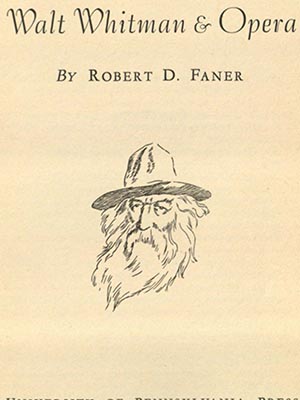Walt Whitman Collection
October 27, 2008
Description by Daniel V. Donatacci, PhD candidate in English and American Literature
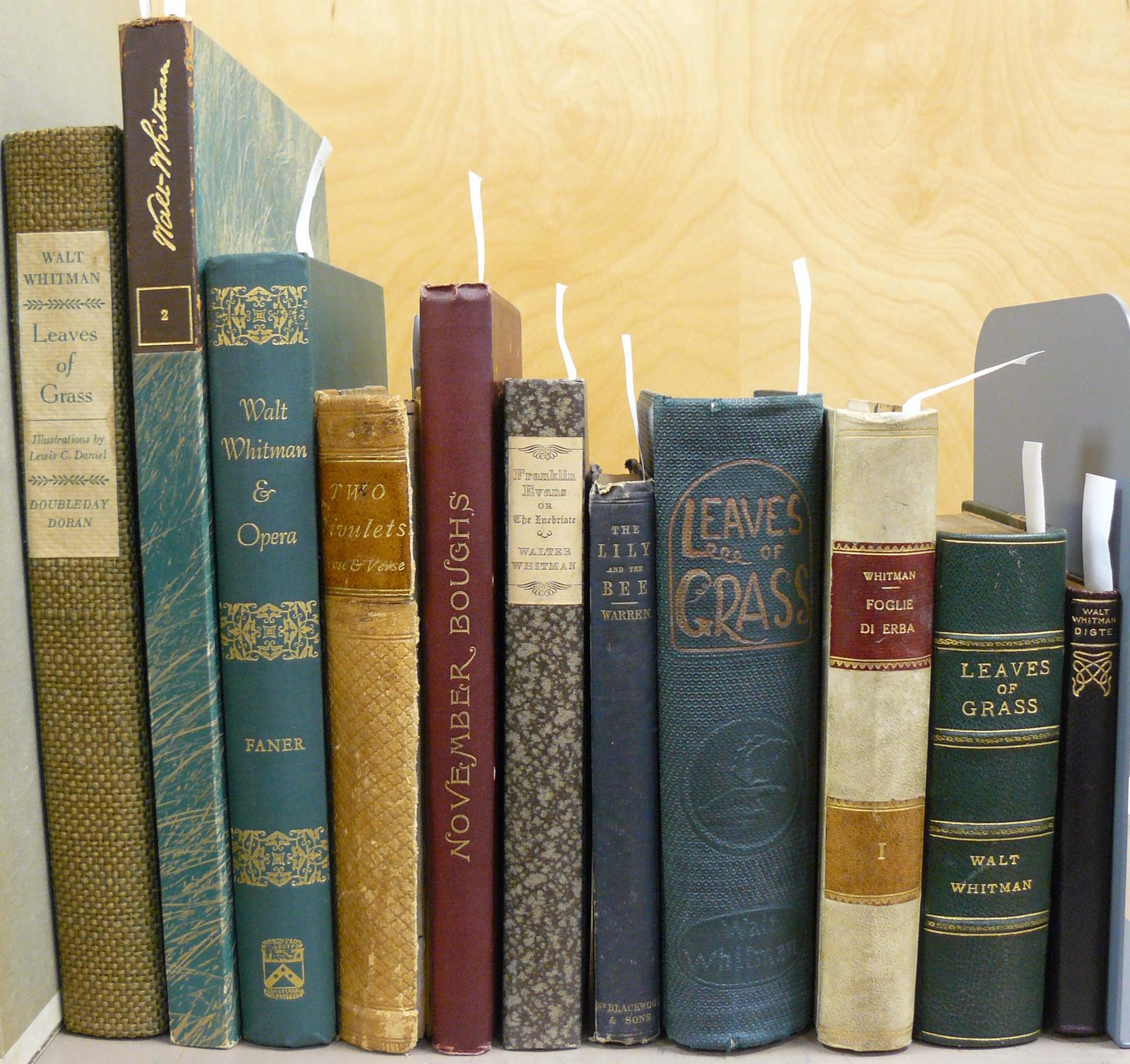 Journalist, critic and feminist Margaret Fuller wrote an essay in 1846 entitled “American Literature; Its Position in the Present Time, and Prospects for the Future.” Its first line read, “Some thinkers may object to this essay, that we are about to write of that which has, as yet, no existence.” Walt Whitman (1819–1892) took up the implicit challenge (as well as explicit ones from other pens, notably Ralph Waldo Emerson’s) and, nine years later, brought out the first edition of his landmark work in verse, Leaves of Grass. The moment was a defining and pivotal event in the history of that which, in the minds of some arguably unimaginative thinkers, did not yet exist; this much is clear to us over 150 years afterwards, but the Whitman we know today is, of course, not the Whitman we knew then. History is tidy only in retrospect. His
Journalist, critic and feminist Margaret Fuller wrote an essay in 1846 entitled “American Literature; Its Position in the Present Time, and Prospects for the Future.” Its first line read, “Some thinkers may object to this essay, that we are about to write of that which has, as yet, no existence.” Walt Whitman (1819–1892) took up the implicit challenge (as well as explicit ones from other pens, notably Ralph Waldo Emerson’s) and, nine years later, brought out the first edition of his landmark work in verse, Leaves of Grass. The moment was a defining and pivotal event in the history of that which, in the minds of some arguably unimaginative thinkers, did not yet exist; this much is clear to us over 150 years afterwards, but the Whitman we know today is, of course, not the Whitman we knew then. History is tidy only in retrospect. His 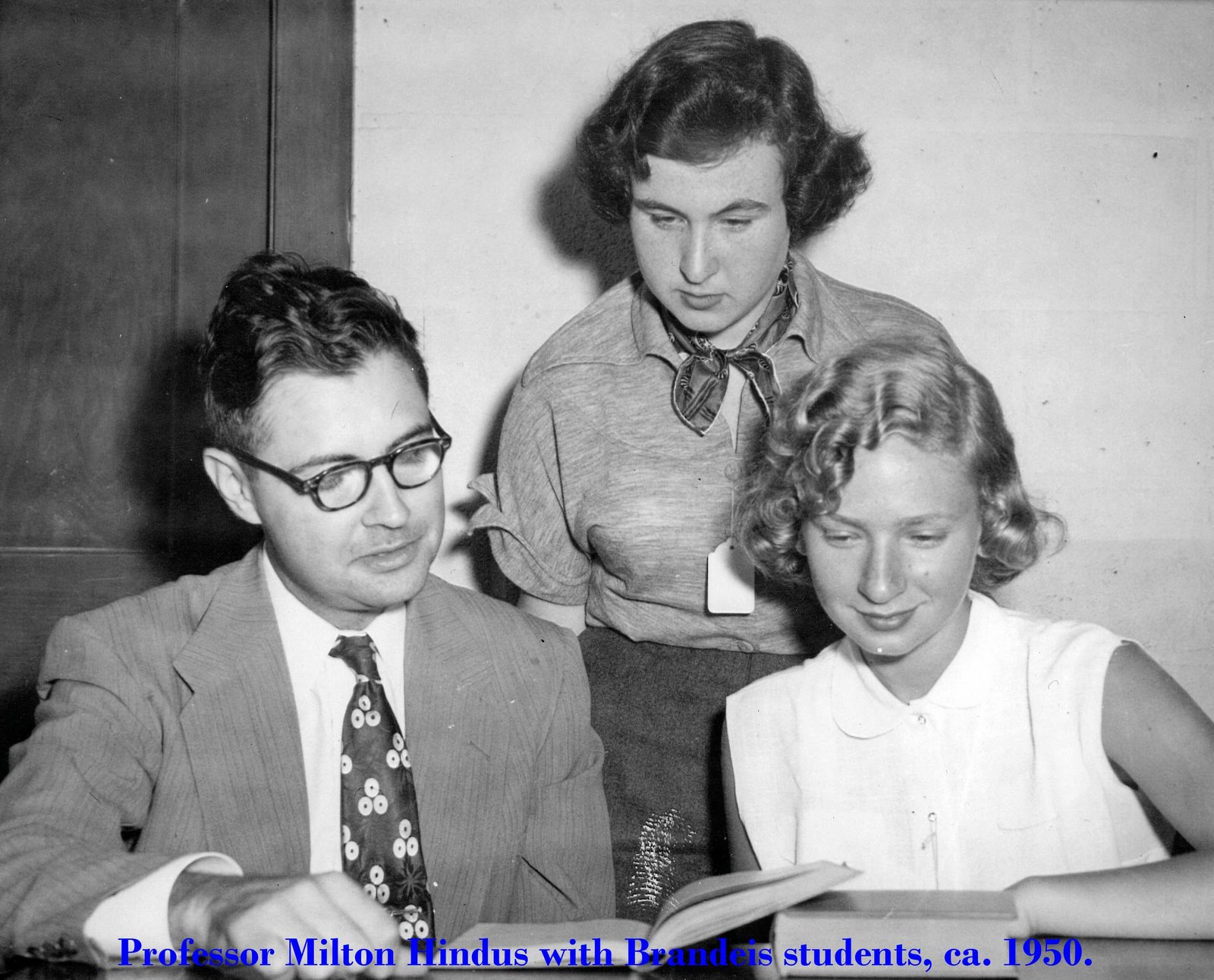 answer to Fuller’s call was immediately if not universally recognized, but as Whitman's reputation evolved over the first hundred years following the work’s first publication, our understanding, like the continual revisions to which he subjected the poems, of the way in which he answered that call has dilated and expanded in directions as unpredictable and provocative as Whitman himself. We can only take stock of that understanding—and attempt to say something useful about it—if we return to and look closely at the texts and artifacts that document it. Brandeis University’s Department of Archives and Special Collections is fortunate to have acquired an interesting and varied assortment of these over the years; our collection affords a broad range of impressions to be had in service of this effort.
answer to Fuller’s call was immediately if not universally recognized, but as Whitman's reputation evolved over the first hundred years following the work’s first publication, our understanding, like the continual revisions to which he subjected the poems, of the way in which he answered that call has dilated and expanded in directions as unpredictable and provocative as Whitman himself. We can only take stock of that understanding—and attempt to say something useful about it—if we return to and look closely at the texts and artifacts that document it. Brandeis University’s Department of Archives and Special Collections is fortunate to have acquired an interesting and varied assortment of these over the years; our collection affords a broad range of impressions to be had in service of this effort.
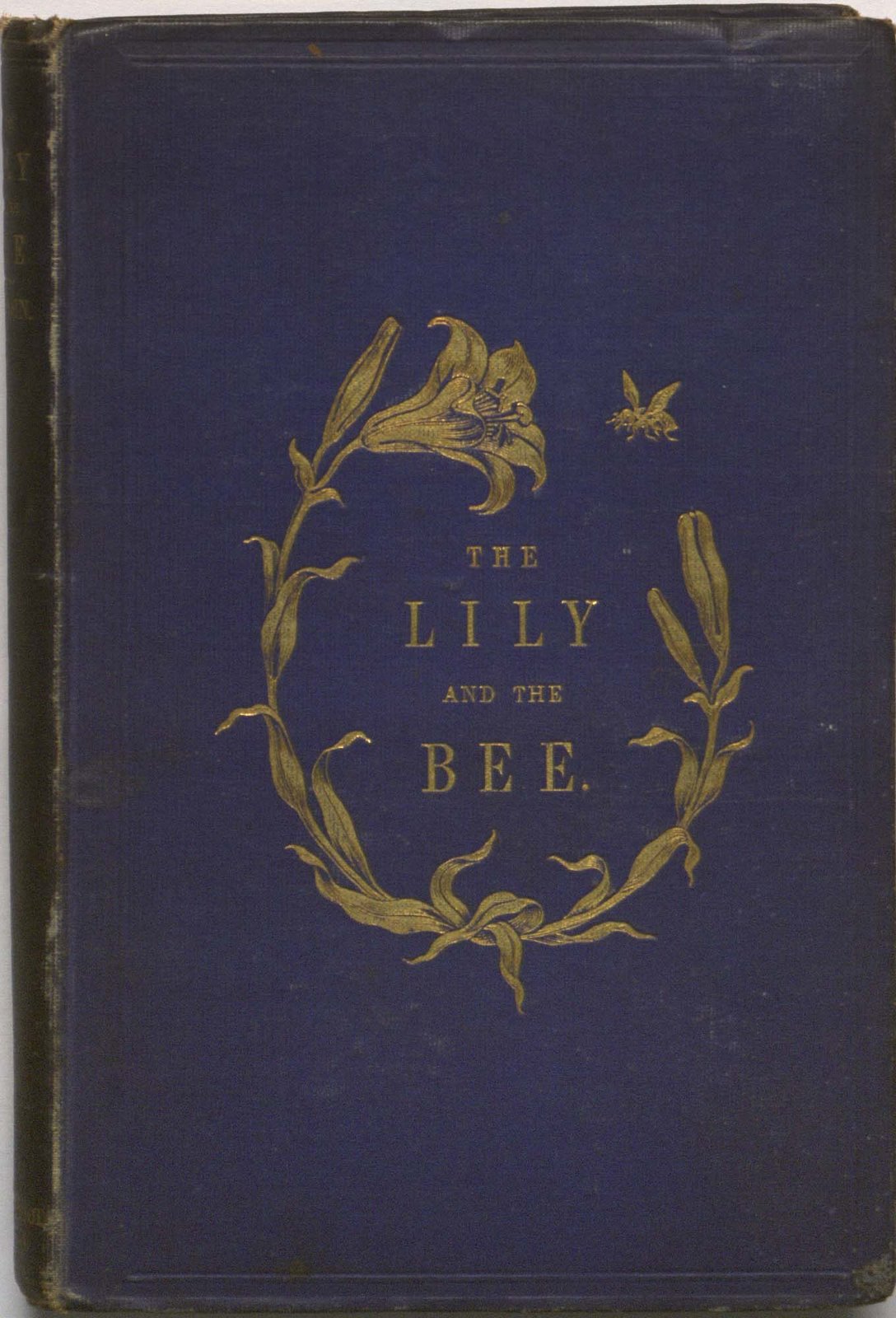
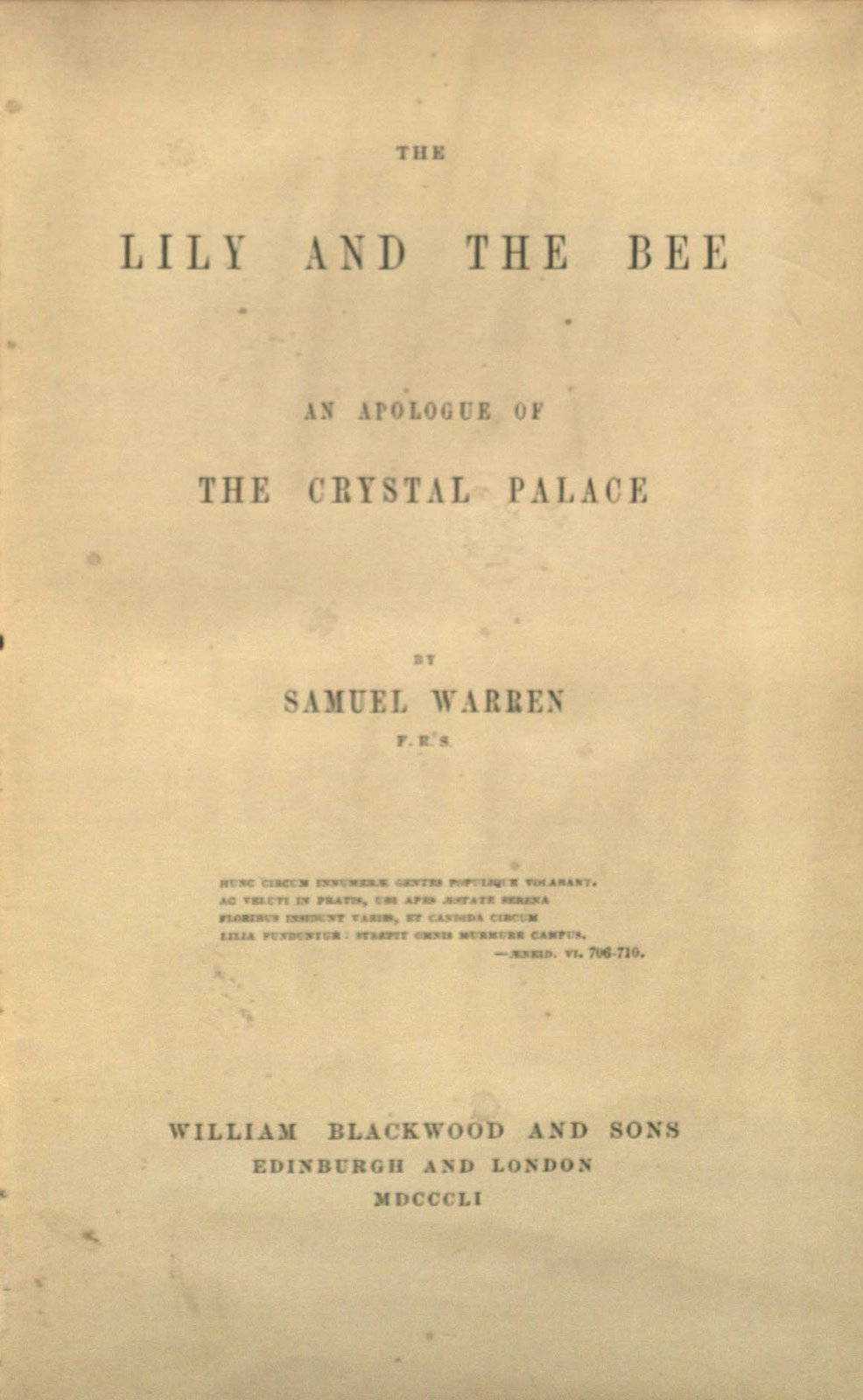 In September of 2008 we held a Show-and-Tell event showcasing a representative selection of our Whitman texts and artifacts; we were terrifically pleased to see so many visitors and regret only that we could not display more as a result of space limitations. We inherited custodianship of these materials from several different sources: some were independently obtained or came as part of larger groups of items that were not all directly related to Whitman; many comprise the collection donated to us by Mitchell Slobodek, one of Brandeis’s early benefactors; and several items came to us via the legacy of Professor Milton Hindus, one of the university’s 13 original faculty members and a renowned Whitman scholar. The items range from first editions of landmark volumes of Whitman scholarship and early confrontations in print of “the Whitman controversy” (or, more accurately, controversies) to numerous early and fine press editions of his poetry and prose, both in book form and in the oftentimes much more difficult-to-find periodicals.
In September of 2008 we held a Show-and-Tell event showcasing a representative selection of our Whitman texts and artifacts; we were terrifically pleased to see so many visitors and regret only that we could not display more as a result of space limitations. We inherited custodianship of these materials from several different sources: some were independently obtained or came as part of larger groups of items that were not all directly related to Whitman; many comprise the collection donated to us by Mitchell Slobodek, one of Brandeis’s early benefactors; and several items came to us via the legacy of Professor Milton Hindus, one of the university’s 13 original faculty members and a renowned Whitman scholar. The items range from first editions of landmark volumes of Whitman scholarship and early confrontations in print of “the Whitman controversy” (or, more accurately, controversies) to numerous early and fine press editions of his poetry and prose, both in book form and in the oftentimes much more difficult-to-find periodicals.
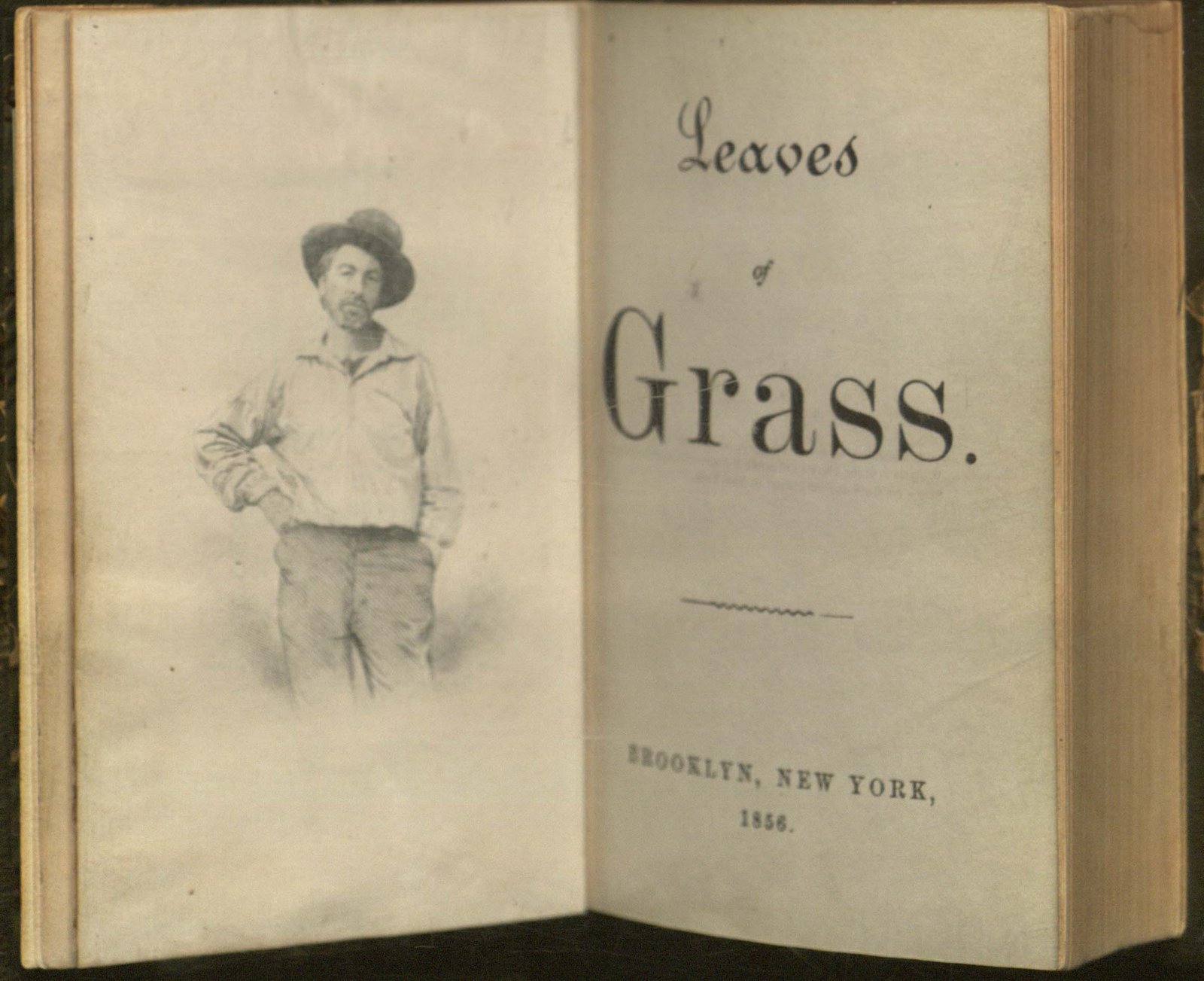 The first edition of Whitman’s major poetic work, Leaves of Grass, was published in 1855 at his own expense, and bore only his image—no name. Though we unfortunately do not have one of these, we are lucky enough to have a copy of the second edition, published in 1856. From the first to the last of the six editions of Leaves of Grass, the structure and layout of the book was invested (to the extent that he could influence them) with as much significance by Whitman as the words themselves. We are reminded of this when we consider his lifelong involvement with printing shops and binderies; he was even known to have set the type for many of his publications himself. The editions in our collection allow this attention on Whitman’s part to the whole work to be examined in careful detail, alongside the work done in a similar spirit by printers of later generations in the form of skillfully and beautifully executed fine-press volumes. Though these later examples, one of which is—amusingly enough—bound in grass, cannot be said necessarily to have lent expression in every case to Whitman’s particular vision of the ideal fusion between the word and its vehicle, it is certainly true that many of them aim at a realization in illustration and form of the themes the poet addressed throughout his career.
The first edition of Whitman’s major poetic work, Leaves of Grass, was published in 1855 at his own expense, and bore only his image—no name. Though we unfortunately do not have one of these, we are lucky enough to have a copy of the second edition, published in 1856. From the first to the last of the six editions of Leaves of Grass, the structure and layout of the book was invested (to the extent that he could influence them) with as much significance by Whitman as the words themselves. We are reminded of this when we consider his lifelong involvement with printing shops and binderies; he was even known to have set the type for many of his publications himself. The editions in our collection allow this attention on Whitman’s part to the whole work to be examined in careful detail, alongside the work done in a similar spirit by printers of later generations in the form of skillfully and beautifully executed fine-press volumes. Though these later examples, one of which is—amusingly enough—bound in grass, cannot be said necessarily to have lent expression in every case to Whitman’s particular vision of the ideal fusion between the word and its vehicle, it is certainly true that many of them aim at a realization in illustration and form of the themes the poet addressed throughout his career.
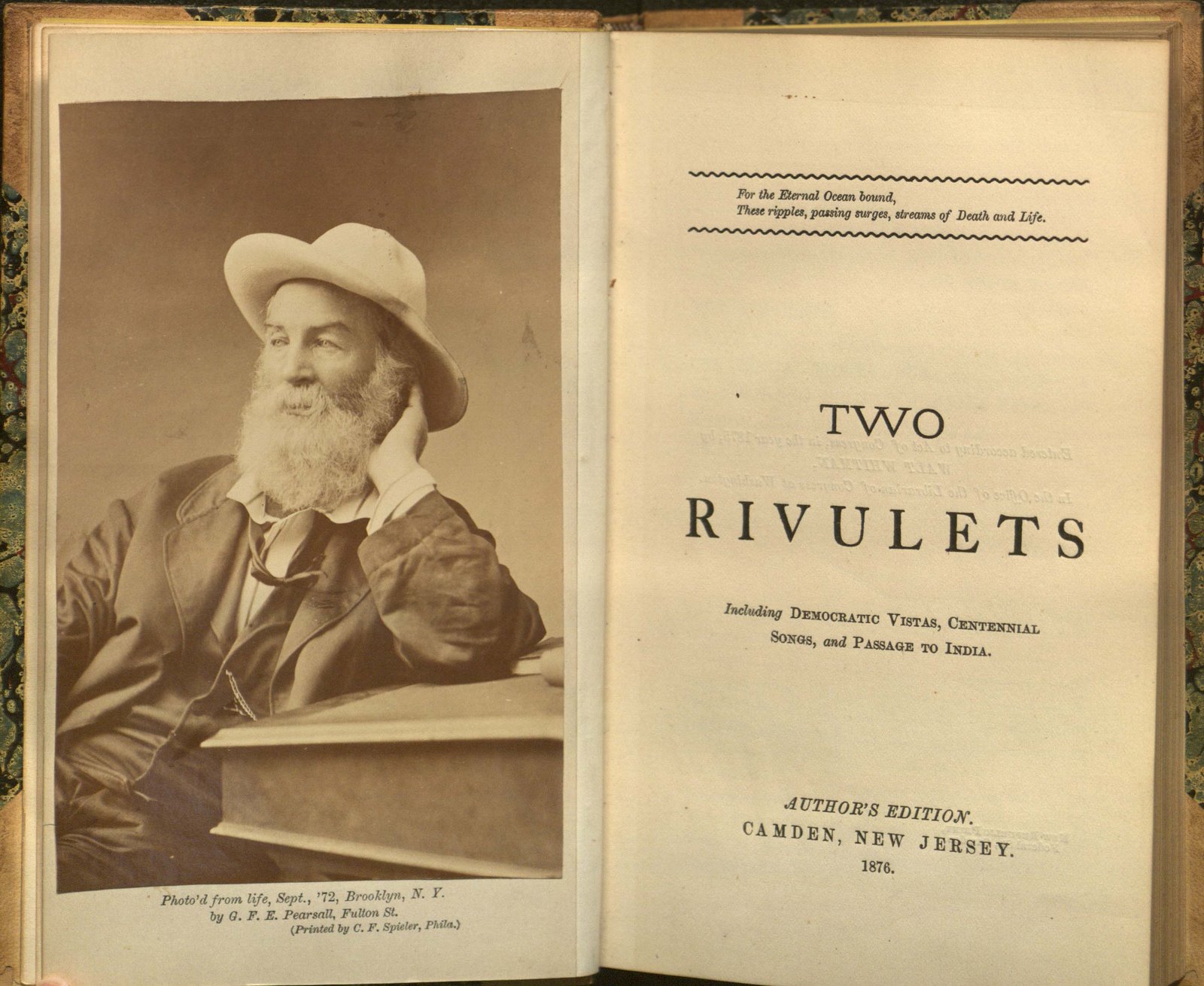 Leaves of Grass, though his best-known work, was not the only form in which Whitman published his poems—nor were the poems, however famous, the only thing he wrote. We have in the collection a wide array of other editions of his poetry and prose, including rare early printings of Drum-Taps, Rivulets of Prose, and November Boughs. Also, we are tremendously lucky to be in possession of a proof sheet for his “Passage to India”—this poem was written in 1868 and published in 1871, first as a separately bound supplement to Leaves of Grass and later incorporated into it.
Leaves of Grass, though his best-known work, was not the only form in which Whitman published his poems—nor were the poems, however famous, the only thing he wrote. We have in the collection a wide array of other editions of his poetry and prose, including rare early printings of Drum-Taps, Rivulets of Prose, and November Boughs. Also, we are tremendously lucky to be in possession of a proof sheet for his “Passage to India”—this poem was written in 1868 and published in 1871, first as a separately bound supplement to Leaves of Grass and later incorporated into it.
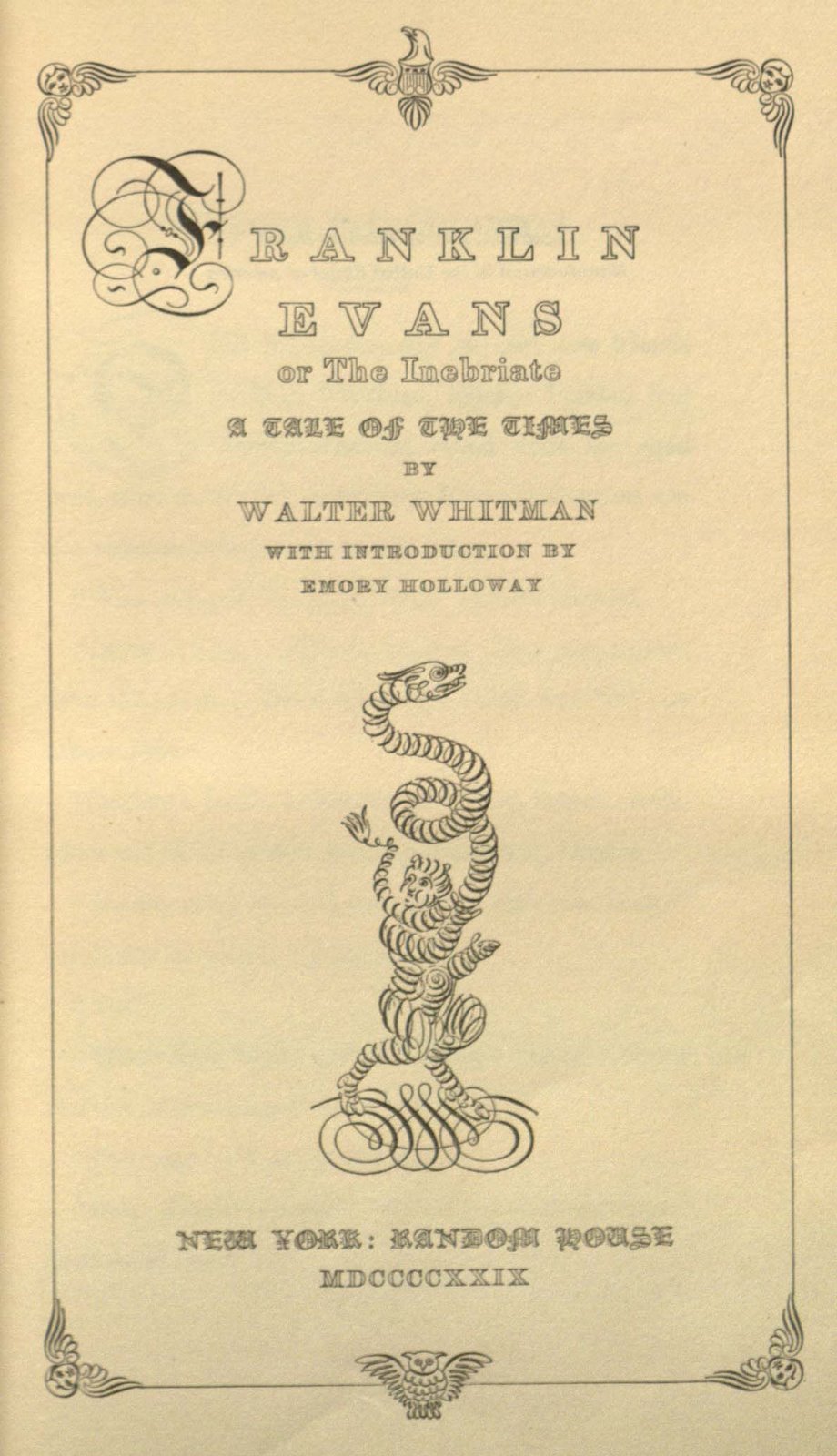 Whitman’s only book-length work of fiction, the temperance novel Franklin Evans; or, the Inebriate: A Tale of the Times, was written and published in 1842 while he was working at Park Benjamin’s printing house in New York. He came to regret having written it later in life, calling it “damned rot” and claiming (perhaps in jest) to his friend Horace Traubel that he actually wrote the novel under the influence of alcohol. As critic William Lyon Phelps pointed out in 1924, “it sounds like a burlesque on a temperance tract.” It was not one of those works to which Whitman tirelessly worked to attract attention; much to his later chagrin, he did not have to, as the novel proved to be one of his life-long bestsellers. We have a very attractively bound edition of it from 1929.
Whitman’s only book-length work of fiction, the temperance novel Franklin Evans; or, the Inebriate: A Tale of the Times, was written and published in 1842 while he was working at Park Benjamin’s printing house in New York. He came to regret having written it later in life, calling it “damned rot” and claiming (perhaps in jest) to his friend Horace Traubel that he actually wrote the novel under the influence of alcohol. As critic William Lyon Phelps pointed out in 1924, “it sounds like a burlesque on a temperance tract.” It was not one of those works to which Whitman tirelessly worked to attract attention; much to his later chagrin, he did not have to, as the novel proved to be one of his life-long bestsellers. We have a very attractively bound edition of it from 1929.
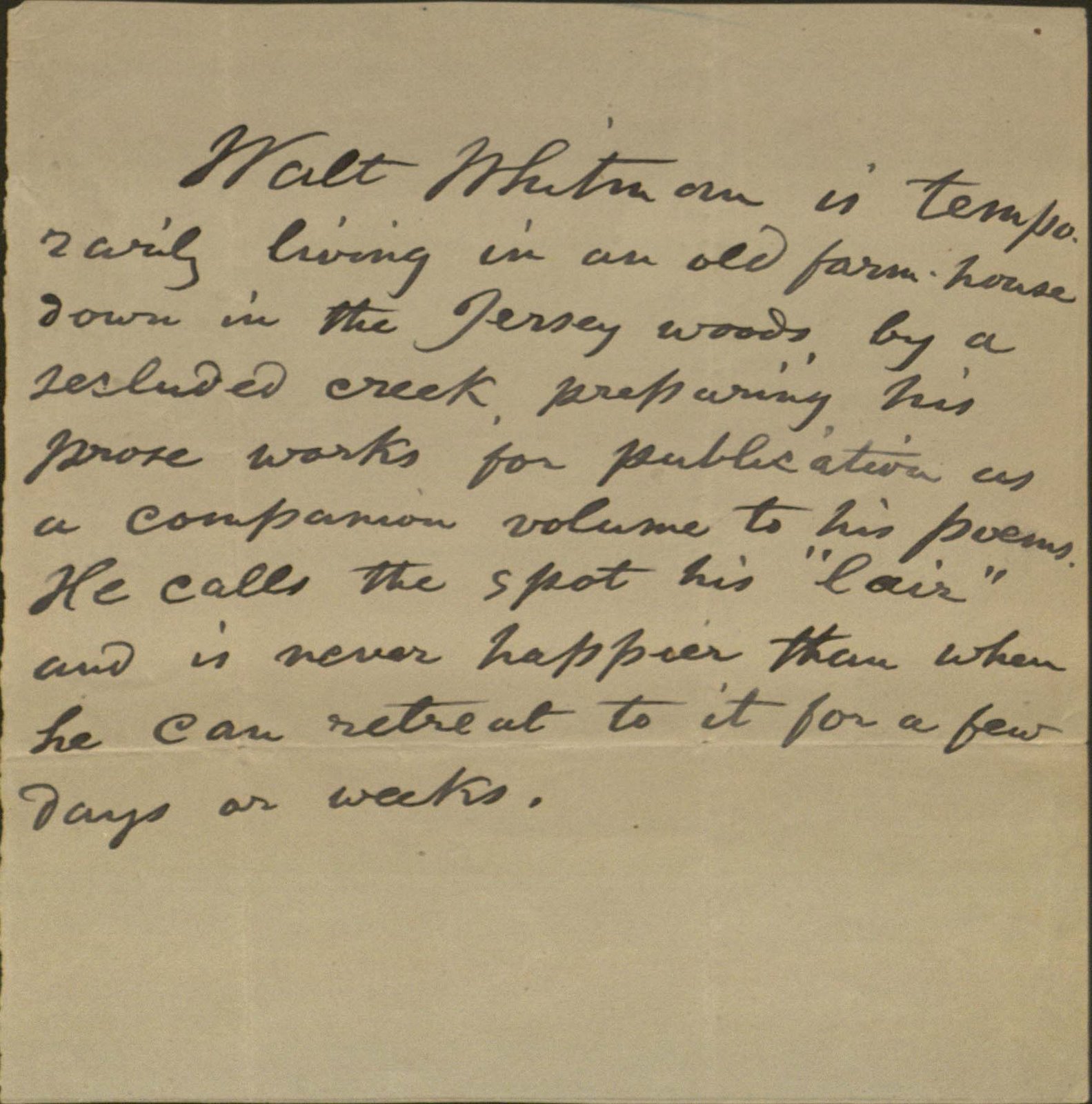 During his lifetime, Whitman’s work was already being brought out in translation and in foreign editions. We have a selection of these from both before and after his death, including French, German and Italian versions of Leaves of Grass as well as some examples of publicity in foreign-language periodicals. Alongside these can be found a rich gathering of early and late scholarship, covering Whitman’s relationship to Lincoln, his oft-commented-upon interest in opera and his voluminous correspondence, among many other subjects; these are fascinating as a group for the perspective they provide in developing our contextual understanding of the ways in which we have understood this “poet of democracy,” in consideration of which we began this posting.
During his lifetime, Whitman’s work was already being brought out in translation and in foreign editions. We have a selection of these from both before and after his death, including French, German and Italian versions of Leaves of Grass as well as some examples of publicity in foreign-language periodicals. Alongside these can be found a rich gathering of early and late scholarship, covering Whitman’s relationship to Lincoln, his oft-commented-upon interest in opera and his voluminous correspondence, among many other subjects; these are fascinating as a group for the perspective they provide in developing our contextual understanding of the ways in which we have understood this “poet of democracy,” in consideration of which we began this posting.
Unfortunately, in the space of such a necessarily brief note we cannot hope, once again, to acquaint you with the full range of artifacts in our collection, but we invite you to visit our website to peruse the online exhibit we have built from these materials.
